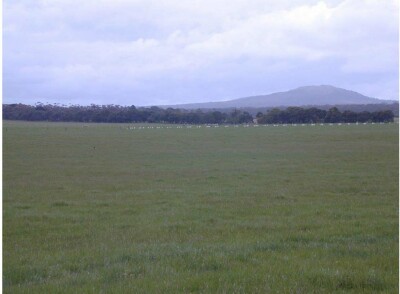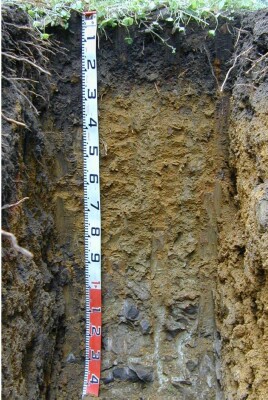GHF09b
Location: Byaduk
Australian Soil Classification: Ferric, Eutrophic, Brown CHROMOSOL
General Landscape Description: Level plain
Site Description: Flat
Land Unit: Warrabkook Basalts
Geology: Quaternary basalt
General Land Unit Description: This land unit consists of gently undulating basalt plains in the Macarthur area. In some drainage lines, the basalt has been dissected sufficiently to expose the underlying sediments. The soils on the basalt plains are commonly Brown Kurosols or Chormosols, intermixed with Sodosols, particularly on the lower slopes and drainage depressions. This site has two year old Eucalyptus globulus in a plantation on ex-agricultural land.

Soil Profile Morphology
Surface
| A1 | 0-10 cm | Very dark grey (10YR3/1); clay loam; weak medium polyhedral structure , parting to weak medium granular structure; very weak consistence when moist; contains a few medium ferruginous nodules; many medium roots present; pH 5.1; clear and smooth transition to:
|  |
| A2 | 10-22 cm | Very dark greyish brown (10YR3/2); clay loam; contains , many medium ferruginous nodules, common subangular moderately strong cobbles; common medium roots present; pH 5.6; abrupt and smooth transition to: | |
| Subsoil
| |||
| B21 | 22-70 cm | Yellowish brown (10YR5/6), with common medium distinct red (2.5YR5/7) mottles; medium clay; moderate coarse polyhedral structure, parting to moderate medium granular structure; weak consistence, moderately moist; contains a few medium ferruginous nodules; common subangular moderately strong cobbles present;contains a few medium roots; pH 5.6; diffuse and smooth transition to:
| |
| B22 | 70-100 cm | Pale brown (10YR6/3), with common medium faint yellowish brown (10YR5/7) and red (2.5YR4/8) mottles; medium heavy clay; moderate coarse polyhedral structure, (parting to moderate medium granular structure; very weak consistence, moderately moist; contains a few medium ferruginous nodules; common subangular moderately strong cobbles present; a few very fine roots present; pH 6.7; clear and smooth transition to:
| |
| C | 100-140 cm | Light grey (10YR7/1); light clay; very abundant coarse fragments present; very weak consistence, moist; contains very abundant subangular moderately strong cobbles; a few very fine roots present; changes to:
| |
| 140-220 cm | Similar to layer above; changes to:
| ||
| 220-410 cm | Mixed mottled clays and decomposing vesicular basalt, the basalt between 100-220 cm is most likely a large floater, live roots observed to 410 cm. |
Key Profile Features:
- Strong texture contrast between surface (A) horizons and subsoil (B21) horizon.
Soil Profile Characteristics:
- | pH | Salinity | ||
Surface Soil (A1 horizon) | Strongly Acid | Very Low | Non-Sodic | None |
Subsoil (B21) | Moderately Acid | Very Low | Non-Sodic | None |
Deeper Subsoil (70-100 cm) | Slightly Acid | Very Low | Marginally Sodic | None |
Chemical and Physical Analysis:
Horizon | Horizon Depth (cm) | pH (water) | pH (CaCl2) | EC dS/m | Exchangeable Aluminium ppm | Exchangeable Acididty meq/100g | Exchangeable Cations | Coarse Sand (0.2-2.0 mm) % | Fine Sand (0.02-0.2 mm) % | Silt (0.002-0.02 mm) % | Clay (<0.002 mm) % | Field Capacity % w/w | Wilting Point % w/w | |||
Ca | Mg | K | Na | |||||||||||||
meq/100g | ||||||||||||||||
A1 | 0-10 | 5.1 | 4.5 | 0.08 | 52 | 15 | 3.6 | 1.6 | 0.14 | 0.16 | 37 | 20 | 12 | 24 | 22.0 | 11.4 |
A2 | 10-22 | 5.6 | 4.8 | 0.07 | 15 | 11 | 3.2 | 1.6 | 0.10 | 0.22 | 38 | 22 | 12 | 26 | 34.7 | 11.7 |
B21 | 22-70 | 6.5 | 6.1 | 0.14 | 9.9 | 5.3 | 6.2 | 0.14 | 0.96 | 6 | 6 | 7 | 81 | 34.9 | 29.9 | |
B22 | 70-100 | 6.7 | 6.0 | 0.14 | 9.6 | 6.4 | 10 | 0.14 | 1.8 | 6 | 13 | 13 | 68 | 37.7 | 29.2 | |
Profile Described By: Ian Sargeant, Paul Feikema and Martin Clark, 3rd November 2000.


